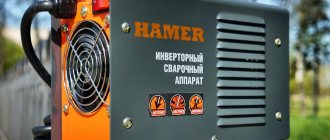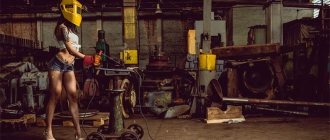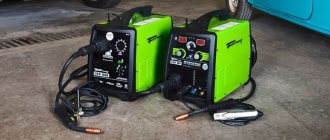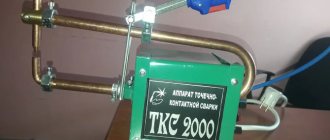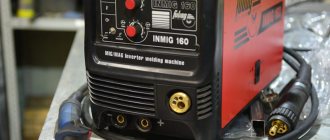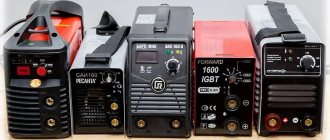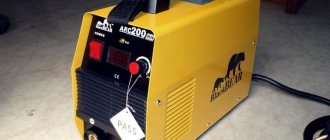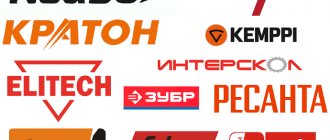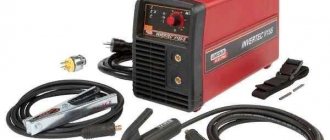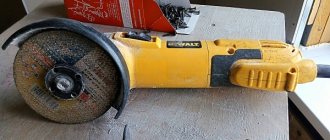Manufacturers offer a large selection of welders operating from a standard network. They are available in different capacities, sizes, and prices. Without knowing the fundamental differences between a semi-automatic welding machine and an inverter, which is better, it is impossible to say for sure. Each equipment has advantages, disadvantages, and a range of welding modes.
Operating principle and distinctive features
First, a few words about operating modes. Semi-automatic machines confidently support the following modes:
- MIG – carbon dioxide welding;
- MAG - an argon cloud is created above the weld pool;
- some have an MMA (manual arc welding with coated electrodes) mode.
Semi-automatic welders are purchased for TIG - argon arc welding using a non-consumable electrode. Leading manufacturers produce combined professional devices that support all modes. But now we are talking about household equipment.
The main difference between welding inverters and semi-automatic machines is the type of additive used. The latter feed welding wire into the working area at a certain speed. When working with an inverter, electrodes with various types of coating are more often used, creating a protective layer of slag on the melt pool. It is more difficult to make an even suture bead using an electrode. Semi-automatic welding is beyond the capabilities of beginners; experience is required.
An ordinary welding inverter is a universal power source with a compact transformer and semiconductor converters. Equipped with additional functions:
- limiting the no-load voltage, maintains a stable arc in conditions of high humidity;
- hot start (Hotstart), providing easy ignition of the arc;
- protection against sticking of the electrode (Antistick), in case of a short circuit the electrode is re-ignited drop by drop;
- arc force (ArcForce), ensures stable welding.
It is convenient for beginners to work with the inverter; the equipment has simple settings, convenient knobs for adjusting the welding current.
A semi-automatic device is a complex device consisting of three main parts:
- current converter;
- in the mechanism that feeds the filler wire, a special cassette with guide rollers is mounted;
- gas supply systems to the working area to protect the melt from oxidation.
Definition
Semi-automatic is a device during operation of which a special wire is automatically fed into the welding zone.
Semi-automatic
An inverter is a compact device that operates in the process of connecting parts using electrodes.
Inverter
Advantages and disadvantages
For ease of equipment evaluation, the main operational characteristics of semi-automatic devices and inverters are summarized in a table.
| View | pros | Cons according to experts |
| Inverter | low price; ease of use; small dimensions, weight - inverters are easy to transport; quick preparation; simple and clear setup; many models of different power; there are additional functions. | expensive repairs, you need to contact service centers; electronic filling is afraid of high humidity and dust; standard set of wires up to 2.5 meters, limits distance from the power grid; Unstable operation at low temperatures. |
| Semi-automatic | high quality of welded joints; the ability to perform complex work that requires a protective atmosphere; stability of the suture roller; high efficiency; welds any metals. | restrictions on dimensions, it is necessary to transport gas equipment and cylinders together with the device; the job requires skills; high price. |
Car body welding
Today we will talk about how and what is the best way to weld the body of our car.
If you, as a true car enthusiast, do not want to trust the repair of your “iron horse” to the wrong hands, especially some minor work, and also want to save a lot, then this article is for you.
Recently, interest in bodywork has been growing. Moreover, many are interested in welding a car body . Someone wants to weld the necessary part or patch, someone wants to pull out a dent, someone wants to correct traces of corrosion. All this can be done with your own hands in the garage. You just need to arm yourself with the necessary tools, study the nuances of the work ahead and practice a little.
Criterias of choice
For your home or cottage, it is better to choose medium-power equipment for welding parts up to 4 mm. When deciding which is better: an inverter or a semi-automatic device, it is worth considering where you will have to work: indoors or outdoors. The semi-automatic device works stably only indoors; the inverter is universal in this regard.
The quality of the welded joint depends on the qualifications of the welder, the correct choice of additive, and the settings of the welding machine. The capabilities of a semi-automatic machine are wider; when using argon or carbon dioxide, the risk of defects in the weld is reduced. Coated electrodes may cause slag inclusions in the diffuse layer.
Comparative assessment of manual arc and semi-automatic welding.
- Log in to reply to this topic
#1 vnuk
- Top
- Insert nickname
#2 ARGONIUS
- Participant
- Messages: 2,578
- City: N. Novgorod
- Top
- Insert nickname
#3 vnuk
- Top
- Insert nickname
#4 ARGONIUS
- City: N. Novgorod
- Top
- Insert nickname
#5 vnuk
Based on the fact that everything is a faucet. equipment is created from scratch in factories and welded semi-automatically, it should be confidently said that yes, it is indeed very reliable, convenient, fast and practical, thanks to fresh and clean metal, which is actually favorable for a semi-automatic machine. As for the repair of welding joints, which already have various inclusions during remelting and accompanying heating, I can confidently say that the electrodes in this version will be more reliable for repairing welding seams, since this brand, which I wrote about, has plasticity, slag protection, which In fact, it saves well from the dirt of old metal, which sometimes cannot be cleaned properly.
- Top
- Insert nickname
#6 ARGONIUS
- City: N. Novgorod
- Top
- Insert nickname
#7 AMBIVERT42
ARGONIUS, sorry for interjecting.
I will add that blind faith in the capabilities of a semi-automatic will continue to feed this topic (about amateurism) for a long time. Firstly, the characteristics of the device must correspond to the work being performed. It often happens that with a low-power semi-automatic they climb to great thicknesses. What happens is a no brainer. Secondly, few people who use semi-automatic machines everywhere think about the cleanliness of the joining surfaces and, moreover, about gas protection.
Here one cannot but agree with vnuk. The main aspect of semi-automatic welding is production. Field repair is the domain of REDS.
The physicomechanics of the deposited metal, first of all, depends on the filler material (the qualification of the welder is by default). Here lies the solution to one of the myths that a semi-automatic machine will a priori be stronger. Copper-plated Sv-08 and allied ones are not made in the "tinkering and soldering" workshops That is why the correspondence between the actual and declared characteristics of the wire is high. In contrast to coated electrodes, the rod of which is often made from nails. A person who does not go into details conducts an experiment: he welded two corners with a semi-automatic machine and a “handle”. He tried to break it. , a piece electrode - it was a mess and it broke. This leads to a conclusion in the style of a woman’s logic: “electrodes suck, semi-automatics rule!” And the fact that each technology has its own limits of applicability is somehow forgotten.
It is better to be a sheep among wise men than a wise man among sheep.
- Top
- Insert nickname
#8 ARGONIUS
- City: N. Novgorod
- Top
- Insert nickname
#9 ARGONIUS
- City: N. Novgorod
- Top
- Insert nickname
#10 vnuk
You see ARGONIUS, you feel it yourself even without asking a question. And I’ll tell you this from experience, from observations of metal. Still, I am more inclined to protect the coating of the Uonium 55 electrode from the Sychevsky plant and the composition of the rod for metal structures in the field than a semi-automatic one. Here at work I have a car, it’s not bad, I haven’t fooled around yet, I think I’ll use pure argon on the weekend, the 22 mm output nozzle was already turned out by a turner, the beer factory in the car got in the way over time.
- Top
- Insert nickname
#11 Isperyanc
vnuk , ARGONIUS ,
On occasion they gave me a pack of the following electrodes:
Looks like they're cooking. I'm going to build up pillars from 114 pipes (wall 4.5 mm) in height https://websvarka.ru/. 3298#entry70906, please suggest the modes for these electrodes for temperatures around zero. Inverter Blueweld 228, as I understand, a plus is supplied to the holder.
Post edited by Isperyanc: 06 March 2014 19:14
- Top
- Insert nickname
#12 AVN
There are things that are prohibited from cooking PDG. In especially critical structures, they try not to weld the first passes of the RADS, but to cut them out and clean them. A semi-automatic machine has two advantages: speed (performance) and low heating. metal, everything else is flaws.
Isperyanc, your modes (N, V, P) are written 8-> on the pack. But they do not always coincide with real working conditions.
- Top
- Insert nickname
#13 ARGONIUS
- City: N. Novgorod
- Top
- Insert nickname
#14 Isperyanc
- Top
- Insert nickname
#15 ARGONIUS
- City: N. Novgorod
In especially critical structures, they try not to weld the first passes of the RADS, but to cut them out and clean them.
Which device is better for home
When choosing welding equipment, the amount of work to be done is assessed. The final answer to the question of which welding machine is better for the home - an inverter or a semi-automatic machine - is obvious.
When there is a dacha, a country house, welders with experience and permission to work with gas equipment prefer to buy household semi-automatic devices of low power and light weight for personal use. This is an economical option, with it you can provide services to your neighbors: weld frames for greenhouses, doors, fencing bases, repair non-ferrous metal products. A break-in never hurts.
There is no need for beginners to purchase a semi-automatic device. For small household work with steel and aluminum, it is better to choose a small inverter power source with easy adjustment. It is not difficult to select the necessary electrodes; they are marked by type of coating and size.
Semi-automatic or inverter?
Dmitry_Pit wrote: Only I have a question, how does it work at reduced voltage? Well, how do you generally approve of the choice or maybe not take it either?
How does it work at reduced voltage? The same as all p/a. He's being capricious. To be honest, I don’t think that the 180 is fundamentally different from the 150. I have just this one, somewhere below there is a topic about it. Simple, easy... but I can’t get rid of the feeling that the feed speed is higher than necessary, but there’s no way to correct it, and this is especially noticeable at low voltage. Again, there is a vague suspicion that the Finns saved space on the input capacitors - at high currents, voltage ripple is immediately noticeable both in the wire feed and in the magnitude of the current, a sea of splashes. In principle, this can be understood in the case (which is already small) in addition to the electronic filling, they managed to leave room for a 5kg coil. Speaking of splashes, the tip gets clogged very quickly, although it is easy to clean. The fear of splashes remained from the old transformer p/a, they flew off greasy, his hands were fried through the gloves. With this one they are somehow harmless, like a sparkler, until, however, you turn it up to the maximum, it really fries to the fullest. The protrusion of the wire from the tip in some clever way affects the current, but I did not fully grasp the pattern; by moving it closer and further from the part, you can select a more even arc burning. There are no balls at the end of the wire, but for some reason, instead of the usual splashes, small pieces of wire, 5-7-10 mm long, often remain on the seam. I don’t know why this happens.
The conclusion at the moment is that it’s worth the money, but I’ll make a reservation right away for my use. I use it mainly for profile (square) pipes; at wall thicknesses of 1.5 mm there is no price for it at all, it’s very convenient. I wouldn’t risk cooking angles larger than 30 with them; there’s nothing to say about channel bars. The current is still small, especially since it produces its 150A at bourgeois 230V, which, alas, is an unattainable dream. In reality, in our networks it is unlikely to squeeze more than 130A out of it.
It has not yet been possible to test it on the mixture. Bought for 1800 rubles, at first he did not want to add argon to the mixture, even when the arrow on the argon reducer pressure gauge hit the limiter. For this reason, in a fit of rage, I began to turn all the adjustments on it (on the mixer) in a row. And this struggle lasted for quite a long time, until something broke through, or maybe it was cleared and the argon was a fool. I quickly adjusted it as best I could - who knows what percentages it turned out to be. You need to bring it to mind, ugh... no time... no desire. Why the fool was so covetous, he saw on the Internet an imported small mixer with adjustment. Mlyn... didn’t come across anywhere, even when ordered.
The last couple of words... I still don’t advise you to take p/a. Think again. A simple inverter is in many ways more practical, take my word for it. Cylinder, refilling - it's a big deal. If you decide to make money with this device, the question is, of course, different... However, it’s up to you to decide, I don’t insist.
Conclusion
For professionals, when choosing a welding machine, the main criterion is the quality of the seam and the strength of the welded joints. Auto repair shops and small repair companies often purchase semi-automatic machines; they are suitable for joining thin and thick-walled steel workpieces and welding non-ferrous metals. The seams are smooth, strong, and sealed.
Beginners who have no experience will not be able to cook with semi-automatic machines. It will take a long time to achieve good seams, the metal will be damaged, and the wire will be wasted. For beginners, an inverter is a good option.
Pros and cons of semi-automatic
The advantages of this type include:
- Low cost;
- The seams are more accurate and of higher quality;
- Welding of thin metals (aluminum, stainless steel, jewelry, galvanized metal) is possible;
- The presence of gas to protect the seam from air and further corrosion (if there is no gas, it is recommended to use flux-cored wire, it has a similar effect);
- Suitable for repairing furniture, cars;
- Without difficulty, reliably connects even damaged or contaminated metal;
- During the process, the slag does not block the seam, so the welder can immediately visually evaluate the result;
- High work capacity.
The disadvantages of a semi-automatic machine include:
- The size and weight of this device do not make it possible to transport it to the required location;
- High power consumption;
- Connection to a household power supply is not possible;
- Weight about 40 kg.
When choosing between an inverter and a semi-automatic machine, several factors must be taken into account. For what purposes is this device needed? A semi-automatic machine is recommended for service stations; it is considered a professional device. Due to the absence of the need to constantly change electrodes, a greater amount of work is possible. The seams are more aesthetic. For domestic use, an inverter is perfect. Connects to a regular home electrical network and does not cause voltage surges. Suitable for beginner welders to gain experience. Versatile and mobile. Has an excellent security system.
How to weld with cored wire
Semi-automatic welding allows for faster welding due to the continuous supply of wire, which serves as filler metal. Thus, it is possible to deposit large volumes on worn surfaces or create long seams on metal structures without the distraction of changing the electrode. The quality of the seam is much better than when working with coated consumables. But the semi-automatic device has one drawback - in addition to the device, it is also necessary to deliver a gas cylinder weighing 83 kg to the workplace. This makes the task much more difficult. A long gas hose is not always at hand. An alternative is flux cored wire welding, which eliminates the use of shielding gas. How does it work, and what are the advantages and disadvantages of the method?
Self shielding wire
To create a weld with an electric arc, it is necessary to protect the weld pool from interaction with gases in the surrounding air. For this purpose, coating of coated electrodes or inert gas is used, supplied around the filler wire from the nozzle of a semi-automatic device. But it is not always possible to deliver a heavy cylinder to the workplace, and the process with coated electrodes is too slow. Therefore, semi-automatic welding with flux-cored wire without gas was developed.
The wire structure is hollow and has several versions with one or two stiffeners. They are formed during the production of this consumable material during the process of laying the powder and turning the tubular structure. The ribs prevent the structure from creasing when lightly accidentally pressed. An electric current is supplied to the wire, which excites the welding arc. The temperature of the latter melts the metal tube from which the seam is formed and the powder contained in it. The mixture forms a gas cloud that protects the molten metal.

